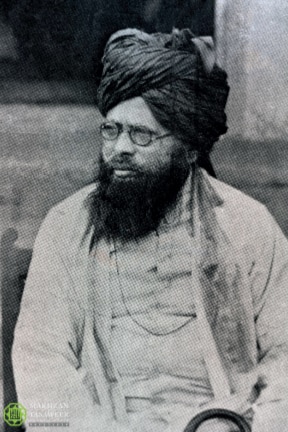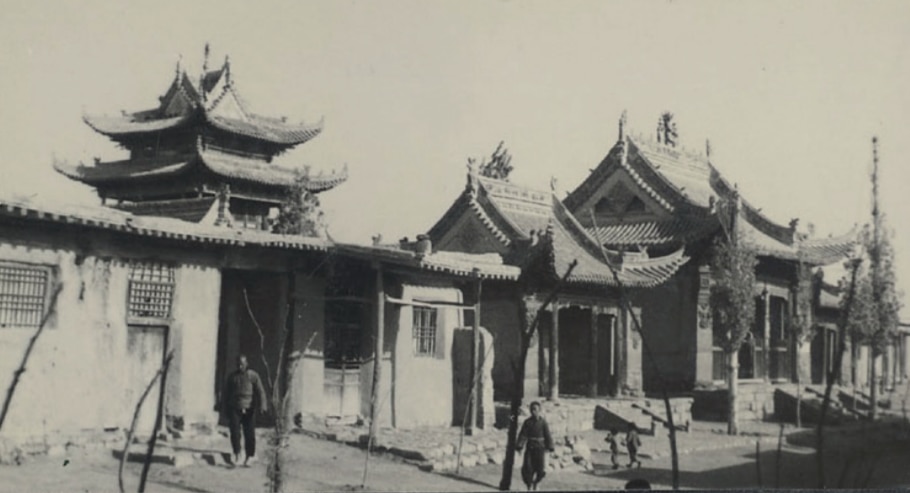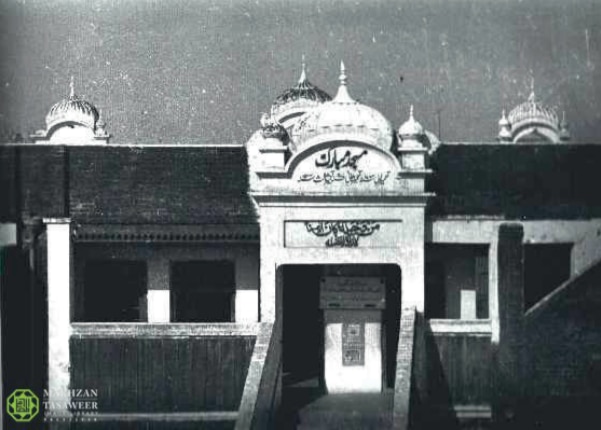A series looking at the high standard of morals of the Promised Messiahas and his Khulafa when receiving visitors in Qadian
Awwab Saad Hayat, Al Hakam

China, a very large country in terms of population and land mass of the Asian continent, has an extraordinary number of Muslims. The seed of Islam was sown there in the very early days of Islam, probably by the hands of the Companionsra of the Holy Prophet Muhammadsa.
An organisation of Chinese Muslims was established under the name of “Chinese Islamic National Salvation Federation”.
According to a report published in Al Fazl, Usman O Sahib, a Chinese Muslim, had been visiting India for about five months. When he reached Lahore, after seeing the famous places of different provinces, he was invited to visit Qadian. He was given an invitation to visit Qadian, which he gladly accepted. On 1 October 1942, at around 11 o’clock in the morning, he reached Qadian by car from Lahore. He was received and warmly welcomed at Hazrat Chaudhry Sir Muhammad Zafrulla Khan’sra residence by dignitaries of the Jamaat which included some Companionsra from different regions and provinces. The distinguished guest shook hands with everyone and greeted everyone with salaam. He conversed with people in English and Chinese. He was delighted to meet Ahmadi youth of the East Indies (present-day Indonesia) and spoke to them in Malay.
After this meeting, he rested for a while and then visited various offices. First, he visited the Khuddam-ul-Ahmadiyya offices, from where he was shown Dar-ul-Mujahideen (office of missionaries). He was then shown the ishaat office where he was gifted a set of books. From there, he was shown the tabligh offices and then the Al Fazl offices. He was then shown a map of the world and was told which countries Islam Ahmadiyyat had spread to.
After this, he went to Madrasa-e-Ahmadiyya, the accounts offices, finance offices, qaza offices, Bahishti Maqbarah offices, office for general affairs, offices for education and tarbiyat and the office of nazir-e-ala. Hazrat Maulvi Abdur Rahim Nayyarra was with him and would introduce each department.

After visiting the offices, he went to see Noor Hospital by car, then Jamia Ahmadiyya, Talim-ul-Islam High School’s swimming pool and boarding facilities. There, when he saw a labourer working on the high school campus, he asked if all the workers were Muslims. He was told that even the sweepers there were Muslims. He shook hands with a sweeper and was happy to hear the Kalima from him. After seeing this, he went to Masjid Aqsa to listen to the dars. Even though he did not understand Urdu, he still listened to the dars attentively. After visiting the offices and factories, he went back to his residence to rest.
Later, in Bait-ul-Zafar (the house of Hazrat Sir Chaudhry Zafrulla Khanra in Qadian), Usman O Sahib was blessed with the opportunity to meet with Hazrat Khalifatul Masih IIra. Since Usman O Sahib was fasting, iftar was arranged by Huzoorra in Bait-ul-Zafar to which some companions of the Promised Messiahas were also invited. After Maghrib, Huzoorra arranged a feast in honour of Usman O Sahib in which about 40 companions were also invited. Since there was also a Chinese family living in Qadian, traditional Chinese dishes were also prepared for the guest. Prior to the food being served, Huzoorra spoke in English about the religious, cultural and social conditions of Chinese Muslims.
Usman O Sahib was actually a Chinese Arab of Owais origin (decedents of Owais al-Qaranira). This is what the O stands for in Usman O Sahib’s name.
During the stay of Usman O Sahib in Qadian, a representative Al Fazl also met and asked him various questions. In response to one question, Usman O Sahib said that the number of Muslims in China was 50 million and the religious and moral condition of people in China was good. He said that people in China were generally interested in praying and fasting. They also had some private schools which provided religious education. He added that the translation of the Holy Quran was available in Chinese; however, there was no formal translation of ahadith.
Usman O Sahib’s visit to Qadian was during World War II. And so, in response to another question, Usman O Sahib said that the closure of the Burma Road (a road linking Burma, now known as Myanmar, with southwest China) could not have any effect on China’s war efforts. The Chinese people did not need aid to continue the war. On the contrary, he added, they had a large number of arsenal and factories in their own country. And they had taken back many cities from the Japanese, Usman O Sahib said.
On 3 October 1942, under the title, “Announcement regarding the speech of Sheikh Muhammad Usman O Sahib”, Al Fazl published an announcement stating that on Friday (the following day), at 9:30 am, Sheikh Muhammad Usman Sahib was to deliver a speech in English in Talim-ul-Islam High School. It was announced that those who understood English should arrive on time and benefit from the speech of the distinguished guest.
On the front page of Al Fazl, dated 4 October 1942, it was stated that on 2 October, the guest, Usman O Sahib, visited Bahishti Maqbarah. He delivered his speech in the hall of Talim-ul-Islam High School at 9:30 am.
Before Usman O Sahib’s speech, Hazrat Maulvi Abdur Rahim Nayyarra told him about Jamaat-e-Ahmadiyya’s preaching efforts. Thereafter, he made his way to the Talim-ul-Islam High School’s hall for his speech. Hazrat Mufti Muhammad Sadiqra presided over this gathering. After the recitation of the Holy Quran and a nazm, a brief introduction of the distinguished guest was given. After that, Usman O Sahib took to the stage.
He began by talking of his visit to India and about Indian Muslims in positive words and conveyed his gratitude for the hospitality he received in Qadian.
After that, he mentioned some interesting things about Chinese Muslims. He said that there were Muslims throughout China; however, their numbers were much higher in the northwest of the country. As far as history shows, he said, Islam came to China in 651 CE. Although it was possible that there were Muslims in China before that. History showed that Islam made great strides in China. Now, Usman Sahib said, the number of Muslims there was close to 50 to 60 million. There were 43,000 mosques. Chinese Muslims were strictly conservative in their religion, Usman Sahib said. They followed the religious rules and instructions very carefully. One would not find any Muslim family where the religion of the husband and wife was not the same.

Usman Sahib added that Chinese Muslims rarely met with non-Muslims and did not eat their cooked food. The Muslims there did not use tobacco. Although some people had started using cigarettes etc., the majority avoided it. Chinese Muslims did not have sects as there were in India. Chinese scholars, who were called akhon (derived from the Arabic word “akh”, meaning brother), were very conservative. Until recently, they considered the translation of the Holy Quran into Chinese against its sanctity; however, Usman Sahib said that it had been 20 years since the Quran was translated. He said that two translations had been rendered by non-Muslims, but there was another translation of a Chinese Muslim scholar named Elias that was considered more authentic. He added that arrangements were being made for another authentic translation.
Some Chinese scholars, despite their proficiency in understanding Arabic and Persian, could not speak the language. If an Arab or an Iranian came, they could not speak to him. That is why Chinese Muslim students had been sent to Egypt for education for 10 or 15 years, so that they could learn modern Arabic there. He said that the Egyptian government was very sympathetic to Chinese Muslims. 20 students were given scholarships by Al-Azhar organisers and 20 students were given scholarships by King Farouk.
Usman Sahib added that he also wanted to send young people to universities in other Islamic countries and added that the purpose of his trip was to make proper arrangements for it. So, he had managed to make arrangements for it at Osmania University and Aligarh University. He said that Chinese students would come after the war. In addition to Egypt, some students had been sent to study at the University of Istanbul. However, he said, he desired to send more students.
Usman O Sahib said that some Chinese traders and hawkers presented themselves as Muslims in India and defamed Chinese Muslims with their behaviour. He said that he had done all research on this matter and stated that they were not Chinese and that he was the first Muslim to come to India from China. None of the hawkers in India, he added, were actually Muslim by faith. They became Muslims just to run their business, said Usman O Sahib.
After concluding his speech, Usman O Sahib visited Masjid Mubarak and requested a farewell meeting with Hazrat Khalifatul Masih IIra, which Huzoorra approved. Usman Sahib was honoured in Qasr-e-Khilafat as a guest. He returned to Lahore by car at around 11 o’clock. Hazrat Maulvi Abdur Rahim Nayyarra also went with him.

After meeting Hazrat Khalifatul Masih, the next day, Usman O Sahib told some friends that Huzoor’sra personality had a profound effect on him. He said that Huzoorra was a very admirable person – his knowledge was vast, he could conduct excellent scholarly discussions on every important subject and he was familiar with many languages.
On page 5 of Al Fazl, dated 25 June 1942, under the headline “Muslim Chinese Representative’s Speech to Muslims in India”, it was reported that Usman O Sahib, the representative of Chinese Muslims to India, and another person who was the representative of the Chinese National Islamic Salvation Federation, during their visit to India, addressed a gathering organised by Muslims in Bombay.
There, they stated that the purpose of their visit was to find out the situation of Indian Muslims in order to establish unity and love between the two countries so that the alienation which had been going on for centuries would be lifted. They further said that they were sent as representatives by the President of the Chinese Islamic National Salvation Federation, General Omar Pai.
In the address, they gave a brief background of Islam in China. They said that the history of Islam in China dated back to the second year of the Yinghui dynasty (651 CE), which was the time of the third Khalifa, Hazrat Uthmanra. He sent an ambassador who was welcomed wholeheartedly by the emperor and from that time, till 1263, Muslim traders came and settled in the border towns and coastal places; however, these people lived a very luxurious and aristocratic life and did not preach. After this period came the most glorious period for Muslims in China. During the Yan and Ying dynasties (1264 to 1643), the names of Muslims and their deeds were memorable in Chinese history. Thereafter came the darkest period in history for Muslims in China. This historic period ended in 1911, during the time of the famous Chinese leader and thinker, Sun Yat-sen.
They added that in 1911, Dr Sun Yat-sen overthrew the Mann-Pen government and established a republic. Since then, a new era of new life and new development had been achieved by the Chinese Muslims.
It will not be out of place to mention that General and Madam Chiang Kai-shek came to Delhi from China in February 1942; and during talks held between the Viceroy of India and General Chiang Kai, it was also decided that a relationship be established between China and India.
On this occasion, in early April 1942, the Viceroy of India wrote a detailed letter to Hazrat Sir Chaudhry Zafrulla Khanra, mentioning the inconvenience and dangers in China and asking him to go to China as the representative of India. A detailed account of Hazrat Chaudhry Zafrulla Khan’sra travels to China, his stay there, his interaction with Chinese Muslims and other important matters are available to read on pages 434 to 443 of Tehdis-e-Nemat.
(In preparation of the above material, the 3 and 4 October 1942 issues of Al Fazl, Tarikh-e-Ahmadiyyat [Vol. 8] and Tehdis-e-Nemat were utilised)

